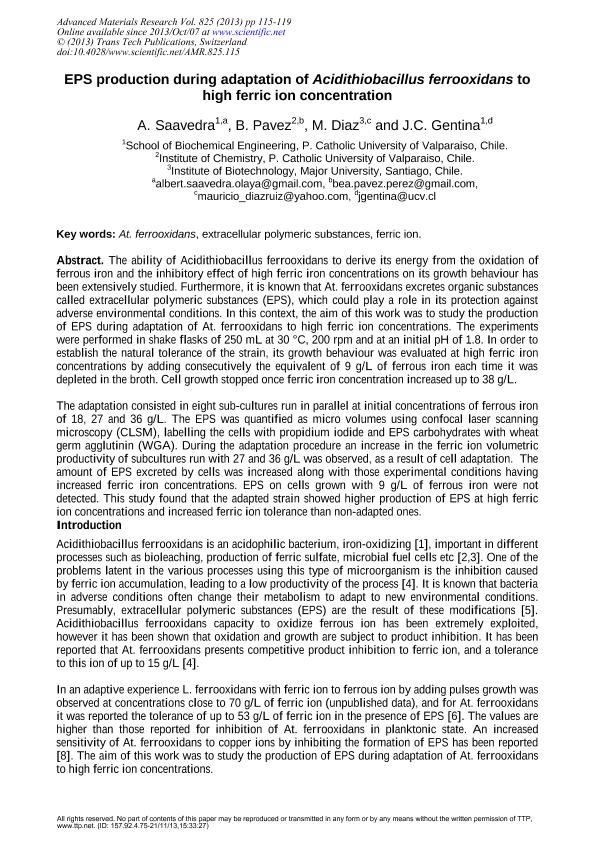Mostrar el registro sencillo del ítem
dc.contributor.author
Saavedra Olaya, Albert Ulises

dc.contributor.author
Pavez, B.
dc.contributor.author
Diaz, M.
dc.contributor.author
Gentina, J. C.
dc.date.available
2017-07-18T18:54:25Z
dc.date.issued
2013-10
dc.identifier.citation
Saavedra Olaya, Albert Ulises; Pavez, B.; Diaz, M.; Gentina, J. C.; EPS production during adaptation of Acidithiobacillus ferrooxidans to high ferric ion concentration; Trans Tech Publications; Advanced Materials Research; 825; 10-2013; 115-119
dc.identifier.issn
1662-8985
dc.identifier.uri
http://hdl.handle.net/11336/20837
dc.description.abstract
The ability of Acidithiobacillus ferrooxidans to derive its energy from the oxidation of ferrous iron and the inhibitory effect of high ferric iron concentrations on its growth behaviour has been extensively studied. Furthermore, it is known that At. ferrooxidans excretes organic substances called extracellular polymeric substances (EPS), which could play a role in its protection against adverse environmental conditions. In this context, the aim of this work was to study the production of EPS during adaptation of At. ferrooxidans to high ferric ion concentrations. The experiments were performed in shake flasks of 250 mL at 30 °C, 200 rpm and at an initial pH of 1.8. In order to establish the natural tolerance of the strain, its growth behaviour was evaluated at high ferric iron concentrations by adding consecutively the equivalent of 9 g/L of ferrous iron each time it was depleted in the broth. Cell growth stopped once ferric iron concentration increased up to 38 g/L. The adaptation consisted in eight sub-cultures run in parallel at initial concentrations of ferrous iron of 18, 27 and 36 g/L. The EPS was quantified as micro volumes using confocal laser scanning microscopy (CLSM), labelling the cells with propidium iodide and EPS carbohydrates with wheat germ agglutinin (WGA). During the adaptation procedure an increase in the ferric ion volumetric productivity of subcultures run with 27 and 36 g/L was observed, as a result of cell adaptation. The amount of EPS excreted by cells was increased along with those experimental conditions having increased ferric iron concentrations. EPS on cells grown with 9 g/L of ferrous iron were not detected. This study found that the adapted strain showed higher production of EPS at high ferric ion concentrations and increased ferric ion tolerance than non-adapted ones.
dc.format
application/pdf
dc.language.iso
eng
dc.publisher
Trans Tech Publications

dc.rights
info:eu-repo/semantics/openAccess
dc.rights.uri
https://creativecommons.org/licenses/by-nc-sa/2.5/ar/
dc.subject
At. Ferrooxidans
dc.subject
Biofilm
dc.subject
Bioleaching
dc.subject
Eps
dc.subject.classification
Bioprocesamiento Tecnológico, Biocatálisis, Fermentación

dc.subject.classification
Biotecnología Industrial

dc.subject.classification
INGENIERÍAS Y TECNOLOGÍAS

dc.title
EPS production during adaptation of Acidithiobacillus ferrooxidans to high ferric ion concentration
dc.type
info:eu-repo/semantics/article
dc.type
info:ar-repo/semantics/artículo
dc.type
info:eu-repo/semantics/publishedVersion
dc.date.updated
2017-07-18T15:36:02Z
dc.journal.volume
825
dc.journal.pagination
115-119
dc.journal.pais
Suiza

dc.journal.ciudad
Zurich
dc.description.fil
Fil: Saavedra Olaya, Albert Ulises. Pontificia Universidad Catolica de Valparaiso; Chile. Consejo Nacional de Investigaciones Científicas y Técnicas; Argentina
dc.description.fil
Fil: Pavez, B.. Pontificia Universidad Catolica de Valparaiso; Chile
dc.description.fil
Fil: Diaz, M.. Universidad Mayor; Chile
dc.description.fil
Fil: Gentina, J. C.. Pontificia Universidad Catolica de Valparaiso; Chile
dc.journal.title
Advanced Materials Research
dc.relation.alternativeid
info:eu-repo/semantics/altIdentifier/doi/http://dx.doi.org/10.4028/www.scientific.net/AMR.825.115
dc.relation.alternativeid
info:eu-repo/semantics/altIdentifier/url/https://www.scientific.net/AMR.825.115
Archivos asociados
